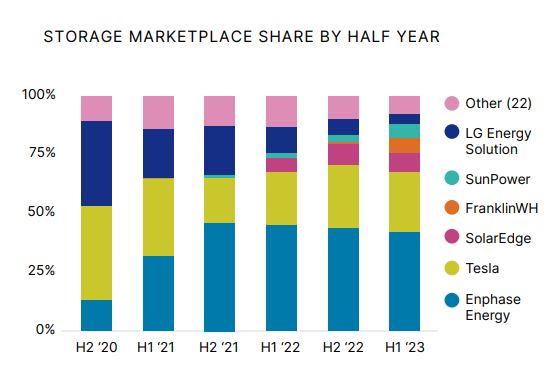Residential energy storage has become an increasingly popular feature of home solar. A recent SunPower survey of more than 1,500 households found that about 40% of Americans worry about power outages on a regular basis. Of the survey respondents actively considering solar for their homes, 70% said they planned to include a battery energy storage system.
Besides providing backup power during outages, many batteries are integrated with technology that allows for intelligent scheduling of the import and export of energy. The goal is to maximize the value of the home’s solar system. And, some batteries are optimized to integrate an electric vehicle charger.
The report noted a steep uptick in consumers showing interest in storage in order to self-supply solar generation, suggesting that lowered net metering rates are discouraging the export of local, clean electricity. Nearly 40% of consumers reported self-supply as a reason for getting a storage quote, up from less than 20% in 2022. Backup power for outages and savings on utility rates were also listed as top reasons for including energy storage in a quote.
Attachment rates of batteries in residential solar projects have climbed steadily in 2020 by 8.1% of residential solar systems attached batteries, according to Lawrence Berkeley National Laboratory, and in 2022 that rate climbed by over 17%.

Life of a battery
Warranty periods can offer a look into installer and manufacturer expectations of the life of a battery. Common warranty periods are typically around 10 years. The warranty for the Enphase IQ Battery, for instance, ends at 10 years or 7,300 cycles, whatever occurs first.
Solar installer Sunrun said batteries can last anywhere between 5-15 years. That means a replacement likely will be needed during the 20-30 year life of a solar system.
Battery life expectancy is mostly driven by usage cycles. As demonstrated by the LG and Tesla product warranties, thresholds of 60% or 70% capacity are warranted through a certain number of charge cycles.
Two use scenarios drive this degradation: overcharge and trickle charge, said the Faraday Institute. Overcharge is the act of pushing current into a battery that is fully charged. Doing this can cause it to overheat, or even potentially catch fire.
Trickle charge involves a process in which the battery is continually charged up to 100%, and inevitably losses take place. The bounce between 100% and just under 100% can elevate internal temperatures, diminishing capacity and lifetime.
Another cause of degradation over time is the loss of mobile lithium-ions in the battery, said Faraday. Side reactions in the battery can trap free usable lithium, thereby lowering capacity gradually.
While cold temperatures can halt a lithium-ion battery from performing, they do not actually degrade the battery or shorten its effective life. Overall battery lifetime is, however, diminished at high temperatures, said Faraday. This is because the electrolyte that sits between the electrodes breaks down at elevated temperatures, causing the battery to lose its capacity for Li-ion shuttling. This can reduce the number of Li-ions the electrode can accept into its structure, depleting the lithium-ion battery capacity.
Maintenance
It is recommended by the National Renewable Energy Laboratory (NREL) to install a battery in a cool, dry place, preferably a garage, where the impact of a fire (a small, but non-zero threat) may be minimized. Batteries and components around them should have proper spacing to allow cooling, and regular maintenance check-ups can be helpful in ensuring optimal operation.
NREL said that whenever possible, avoid repeated deep discharging of batteries, as the more it is discharged, the shorter the lifetime. If the home battery is discharged deeply every day, it may be time to increase the battery bank’s size.
Batteries in series should be kept at the same charge, said NREL. Though the entire battery bank may display an overall charge of 24 volts, there can be varied voltage among the batteries, which is less beneficial to protecting the entire system over the long run. Additionally, NREL recommended that the correct voltage set points are set for chargers and charge controllers, as determined by the manufacturer.
Inspections should occur frequently, too, said NREL. Some things to look for include leakage (buildup on the outside of the battery), appropriate fluid levels, and equal voltage. NREL said each battery manufacturer may have additional recommendations, so checking maintenance and data sheets on a battery is a best practice.
Post time: Apr-21-2024